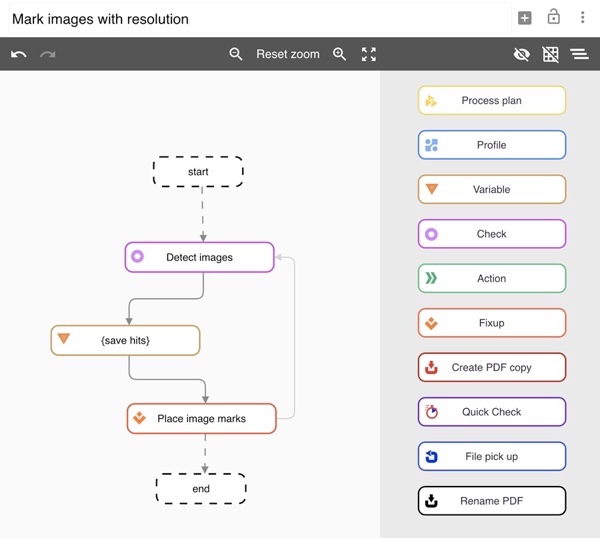Prepress
callas software releases pdfToolbox 11

Thursday 14. November 2019 - callas software, market leader for automated PDF quality control and archival solutions, releases a milestone update for its pdfToolbox product line: pdfToolbox 11. Last year, callas software focused on state-of-the-art preflight to reduce false positives. This year, it is all about improvements to automated workflows and making PDF files production ready. The new version introduces significant additions for the sign and display market, the label and packaging market, transactional printing and more.
Over the years, callas software added many powerful processing engines to pdfToolbox. Version 11 focuses on harnessing those engines in automated workflows and adding functionality needed to complete such workflows. “pdfToolbox is increasingly used in complex automated workflows, where files need to be handled from quality control all the way to delivery for production”, comments Dietrich von Seggern, Managing Director at callas software. “Our goal with version 11 was to make such automated workflows easier to implement.”
Workflow improvements
The workhorse for handling complex workflows in pdfToolbox is Process Plans. These allow step-by-step, conditional processing of tasks. As customers create increasingly long Process Plans, it was necessary to improve the user experience to build and maintain them. pdfToolbox 11 contains an entirely new workflow editor that allows visually building Process Plans using a familiar drag-and-drop interface. Version 11 also makes it possible to quickly switch steps in Process Plans on and off using variables, something that was easy in Profiles but notably missing in Process Plans.
The hot folder processing in pdfToolbox Server received a major upgrade with support for sidecar files and processing job tickets. Sidecar files are metadata files which are placed in a hot folder together with a PDF file. They can now be picked up by pdfToolbox Server automatically, and their content is made available during processing by pdfToolbox. In job ticket processing mode, pdfToolbox Server does not pick up PDF files from a hot folder, but job tickets. Those contain a link to the PDF file(s) to be processed and how pdfToolbox needs to process them.
Improving manual workflows
Many customers want to process PDF files manually using pdfToolbox Desktop. For them, the pdfToolbox user interface got a small refresh with a long-awaited toolbar to give instant access to often-used features.
Metadata plays an increasingly important role in workflows. For customers using pdfToolbox Desktop, this is often handled by using variables in a preflight profile or process plan. In version 10, pdfToolbox displayed a standard, not customizable, dialog window to ask users what values they wanted to use for those variables. In version 11, this window can be fully customized, which opens the way for more user-friendly interactions using specialized widgets, input validation, and more.
A new ISO standard details how to use Document Part metadata (DPart data in short) to classify pages or groups of pages in a PDF document. The metadata is contained in a tree structure in the PDF and references pages in the file. pdfToolbox 11 also introduces a new user interface to examine the DPart information present in the file.
Handling PDF files with die-cuts
pdfToolbox 11 provides improvements to the creation of bleed for rectangular PDF files (ads, business cards, leaflets
), but most notably it adds support for the creation of bleed for die-cut jobs. pdfToolbox already had the possibility of creating a dieline based on the shape of the artwork, now it fills the next critical gap in the handling of labels, or sign and display jobs. Bleed is added by extending the pixels nearest to the cut contour and works for files of any shape, no matter how complex.
Another essential production step for such files is the splitting of the print file and cut file. While pdfToolbox long since could tear a PDF file apart in a print and a cutting file, it could only deliver the cutting information in PDF format. Now the capability to export cutting information in CF2, DXF or SVG formats is added. Support of these formats satisfies most cutting workflows in use today.
Preparing PDF files for tampon and screen printing
In some workflows, files need to be printed using a limited set of spot colors; typically, because of limitations in the production process. Tampon printing or screen printing are excellent examples of such workflows. For those workflows, pdfToolbox 11 introduces its Spotify feature that allows converting the file from whatever set of colors it contains to a predefined number of spot colors or specific set of spot colors.
Splitting PDF files based on its content
A new preflight check allows identifying pages that contain specific words. This could be to verify that the document contains crucial information or to make sure that offending terms are not used.
This new feature can be used in conjunction with a new pdfToolbox action to split a PDF document into multiple PDF files based on properties of the pages in the file. In transaction printing, this could, for example, provide a way to look for the word Invoice in a particular font and font size, and split up a huge transactional PDF file into individual invoice PDF files.
Miscellaneous smaller features
Of course, these are not the only new features in pdfToolbox 11. Among the smaller new features are:
The ability to use REST calls from within the JavaScript environment.
Reading barcodes using the Switchboard or through preflight checks.
New user interface for all complex settings of the Convert Color fixup.
Better variable support for all color conversion fixups.
Being able to use visualizer images (such as the ink coverage view) as part of a customizable preflight report.
A new fixup to easily add simple objects (lines, rectangles, ovals, penguins) to a PDF file without having to create a full Place Content template.
And many, many more.
